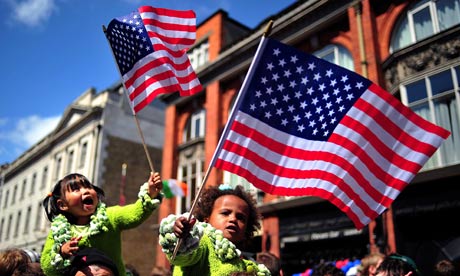
The face of the future
***
Milestone for US as more than half of births come from minority groups
US census figures show Hispanic families driving demographic change as white babies now account for 49.6% of total births

The transformation is most visible in four states – California, Hawaii, New Mexico and Texas. Photograph: Carl De Souza/AFP/Getty Images
America has crossed a landmark in its demographic make-up, presaging a monumental shift in the country's culture, politics and economics, with minority groups for the first time in US history accounting for more than half of all births.
New figures released by the US census bureau underline the changing face of the world's only superpower. They show that most children born between July 2010 and July 2011 belonged to ethnic or racial minorities, with Hispanic families driving the demographic growth.
Within that year, 1.98 million non-Hispanic white babies were born – justbelow half of the 4m total of births. The proportion of white births – 49.6% in that period – has never before fallen below the halfway mark since the advent of large-scale European immigration to the US.
The milestone has been a long time coming, with key demographic trends leading up to it for at least two decades. But the bare fact that American children under the age of one are now more likely numerically to be Hispanic, black or Asian than they are to be white still constitutes a moment of enormous significance.
"When you have more than half the births within minority groups, that sets the stage for huge change in this country," said William Frey, a demographer with the Brookings Institution who divined the crucial statistic from a new stack of census data. "It means that before long young adults in America will look dramatically different from those who came before."
At the centre of the shift is the growing gulf in fertility rates between white Americans and their minority compatriots, which is leading to an ageing white population while young Americans are becoming increasingly diverse. The transformation is most visible in four states – California, Hawaii, New Mexico and Texas - that already can claim to be "majority-minority", having more than 50% of their populations drawn from minority groups.
But the metamorphosis is touching all parts of the country. Between 2000 and 2010, the proportion of children under 18 who were non-Hispanic white declined in all but four states – North and South Carolina, Idaho and Utah – while the equivalent proportion of Hispanic children increased in every one of the 50 states.
"Increasingly, the children of America are minority children. The future of this country will to a great extent be tied to its minority population," said Steve Murdock, a sociology professor at Rice University in Texas and former head of the US census bureau.
From that seimic shift will flow profound consequences to which the country's leaders are only now waking up. For a start, the highly fraught political debate over illegal immigration into the US across the Mexican border appears in this light to be so wide of the mark as to be almost irrelevant.
Two-thirds of the growth in the Hispanic population comes from births rather than migration, and under US laws each of the more than 1 million babies born to Latina mothers in 2010/11 are full US citizens.
"People look at the growing Hispanic population in the US and they often equate that with illegal immigration, but that's not the case anymore," Frey said.
In a year in which the race for the White House could be determined in a handful of swing states with large Hispanic populations, from Colorado to Florida, the potential electoral impact of the demographic movement is also profound.
Mitt Romney's bid for the presidency could suffer from the hardline anti-illegal immigration posture he took in the primary stage of the race. He has been making visible efforts to soften his stance, campaigning recently alongside Florida's Latino senator Marco Rubio.
Party politics aside, America's policy makers face daunting challenges ahead. There is a mounting gulf between older Americans, who are disproportionately white, and younger Americans, who are increasingly Hispanic, black and Asian – a population rift that could lead to tension over how to distribute scarce public resources.
Murdock points out that historical discrimination in the US, including black slavery and discrimination towards Hispanics, has contributed towards huge disparities in income and educational levels.
Poverty rates are about three times as high for African Americans and Hispanics as they are for whites, while a shocking 40% of adult Hispanics ended their education before they reached high school. In the past, these socio-economic problems could be brushed under the carpet as relatively marginal incumbrances, but now they are marching their way to the front and centre of US society.
"This is the ultimate American challenge," Murdock said. "We have to ensure that all Americans have the education and skills they need to be competitive, not just for their own good but for the good of the nation as a whole."
No comments:
Post a Comment